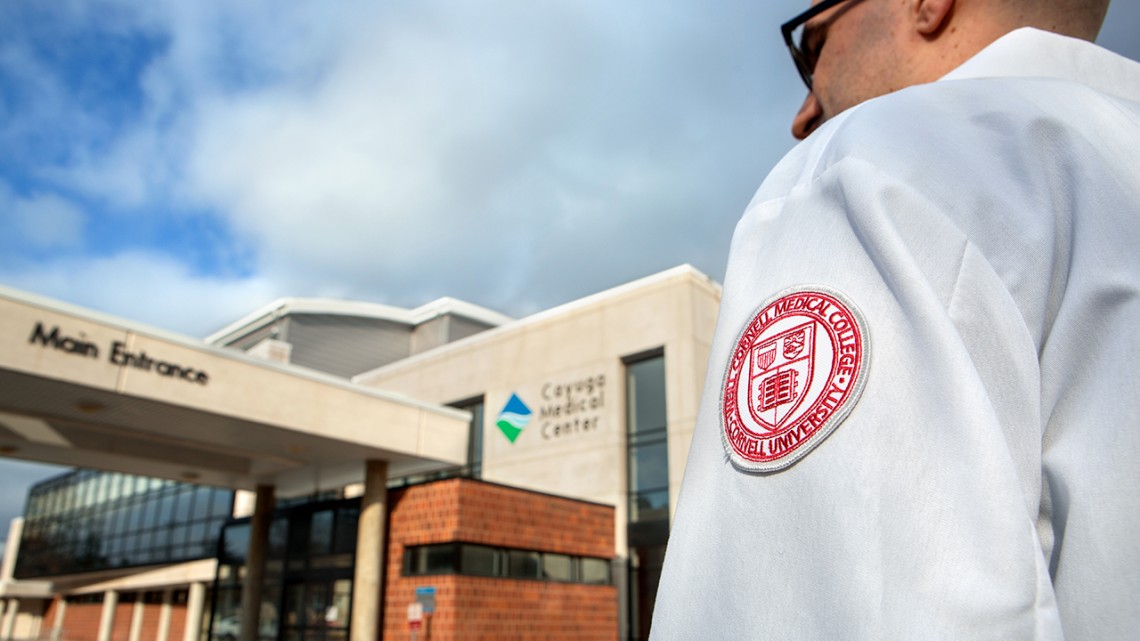
Cayuga Medical Center in Ithaca.
Faculty help hospitalized patients stay connected
By Linda B. Glaser
For hospitalized patients during the COVID-19 pandemic, staying connected to their loved ones has been difficult, if not impossible.
To help stop the spread of the coronavirus, visitation has been severely restricted, leaving patients often feeling alone and frightened and families unable to see and support them. In response, two Cornell professors have organized a project to bring computer tablets to the bedside of each patient at Cayuga Medical Center.
These will also be used to enhance communication in other areas of the hospital, such as the emergency department, and to increase patient and family access to other hospital support services, such as pastoral care.
Although newly launched, the project is moving at lightning speed – for obvious reasons, organizers said.
“Families are so distraught when they can’t talk to their loved ones. We want to make a difference as quickly as possible,” said Kim Overby, professor of the practice in the Department of Science and Technology Studies (S&TS) in the College of Arts and Sciences.
Overby is spearheading the project along with Malte Ziewitz, assistant professor and Mills Family Faculty Fellow in S&TS.
“Cornell University continues to be a tremendous partner for the Cayuga Health System during the COVID-19 public health emergency,” said Dr. Martin Stallone, CEO of Cayuga Health. “One of the most difficult things we implemented was restricting visitors to the hospital, at the direction of the New York State Department of Health. Families and friends are a big part of the healing process for patients in the hospital.
“Cornell stepped up with a great solution,” Stallone said. “We are very grateful for this connection with Cornell that has supported us in so many ways.”
CMC needs approximately 150 tablets to achieve the project’s goals. And while cash donations are welcome, the organizers are primarily seeking donations of used, but functional, iPads and other tablets.
Overby said that everyone is so enthusiastic about wanting to help that although this initiative has just begun, several donated devices have already been received. She’s hoping that they will get enough equipment to also help assisted living and rehabilitation centers, where residents’ families are restricted from visiting.
“This project could have a long-lasting impact for patients, families and caregivers, helping them to be able to communicate in the future,” Overby said.
But getting tablets into patients’ hands is only the first step: They also have to know how to use them. Not all patients are comfortable or familiar with computer technology, said Ziewitz, so he is working in collaboration with CMC’s chief information officer, Brett Mello, to set up a student-operated helpline.
“Patients might have questions about how to open an app or initiate a call,” Ziewitz said. ”Front-line staff are the first people patients ask for help when they get stuck, and the staff don’t have time to provide that kind of help.”
When Ziewitz put out a call for volunteers to S&TS students, he was startled by the huge number of responses he got, despite the students’ own sometimes difficult situations at home. He’s working with a core group of the volunteers to work out the logistics of the helpline.
Within a week, the group hopes to begin training other student volunteers.
Besides understanding the technology, Ziewitz said the students will have to be good listeners and provide moral support to callers.
“We know from research that there’s no such thing as just tech support,” Ziewitz said. “It’s always a human relationship, and this is particularly important when people are on their own in a hospital.”
He added that because many S&TS students – particularly in the biology and society major – are pre-med and have worked in health care before, they’re “nicely qualified“ for the helpline.
The hospital setting offers its own unique challenges. Careful attention is being paid to making it easy for patients to use the tablets and also to infection control issues. And while some patients will be able to hold the tablets in their hands, others may be too weak or unable to do so. In the past, for patients who can’t sit up, CMC has mounted an iPad on an IV pole, a makeshift but workable solution.
The problem now, said Ziewitz, is that like so much other medical equipment, IV poles are in short supply. The project team will focus first on basic setup and table-top tablet supports, then explore other possibilities, such as designing a “computer on a stick” system, which would be particularly ideal for the emergency room.
The project team is also exploring ways to mitigate the disparities faced by some patients and their families who don’t have access to reliable wifi or computers or even to smartphones.
Once in place, the tablet technology will be able to serve multiple purposes for patients, said Overby, such as providing bedside access to CMC’s digital translation software.
“The priority right now is to deal with the loneliness and to let patients speak to their family and friends,” said Overby, “but this project will have a positive ripple effect in other ways for the future.”
Linda B. Glaser is the news and media relations manager for the College of Arts and Sciences.
Media Contact
Get Cornell news delivered right to your inbox.
Subscribe
